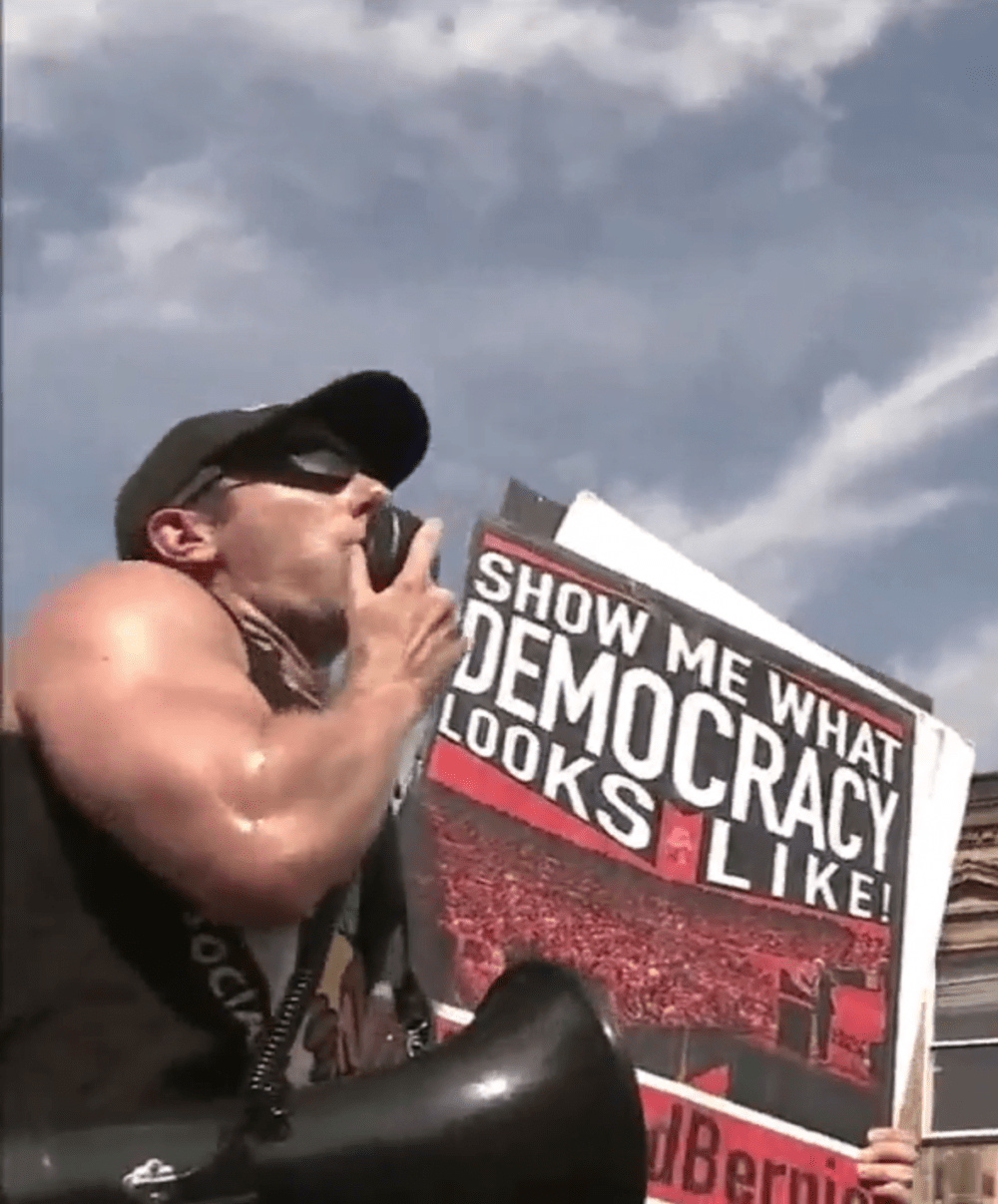Far Out, Cordoned Off

The past week of national media coverage has been fixated on a convention on the verge of revolt. Inside the auditorium, no boo went unnoticed. On Tuesday, a walkout led half the press corps out with it; a surprise appearance by Jill Stein even led some reporters to Google her for the first time.
The consensus may be that the “chaos” here in Philadelphia was barely contained—but in reality, the containment was almost complete. The Sanders protesters inside the perimeter, for all their righteous noise, became the kind of melodrama you hardly have to leave the press tent to observe. They gave speakers and staff a taste of democracy in action! without requiring anyone to get too far away from the tech booths, the Xfinity giveaway tent, or the CNN Grill (food and drink for all!).
I do not know how many protests have taken place over the past week in Philadelphia. Dozens. Hundreds, if you count every discrete act that could be called a protest: the marches and the rallies and the placard-waving individuals decked out in pins, cornering anyone who will listen, not ready to go home. I have spent nearly every daylight hour of this past week at some protest or another, but the itinerary I made last weekend—listing actions I knew about in advance—went largely untouched. I could have gone without that list entirely: if I had only walked down the major streets, from City Hall to Marconi Plaza, to Franklin Delano Roosevelt park on the far side of the Wells Fargo Center, I would have found more chanting than I could have recorded in a month.
Protesters burned flags, got arrested, heckled one another, set up tents and tables, and gave one another free food. Some have made this their vocation, even their occupation—they travel from city to city to organize—while others have never raised their voice at a stranger. They gathered in dozens of buildings and squares, setting out and converging and breaking up again. But they were—even when they stood as close as they could legally come to the Democratic National Convention—very difficult to see.
In Cleveland, journalists entering the Quicken Loans Arena found it difficult to avoid passing through the designated protest zone, but in Philadelphia, there was no such inconvenience. The Wells Fargo Center is in a desert, an enormous parking lot housing three stadiums in South Philadelphia, bordered by a freeway and wide avenues in mature urban decay. The convention’s approved protest zone was on the west side of the perimeter, on Broad Street and in the expansive, secluded FDR Park beyond. Most convention guests came from other directions—from the Uber drop-off point, or from the media parking lot—but even if you deigned to use public transit and emerged from the Septa Station (sponsored by AT&T) on the west side, you emerged just inside a black fence over ten feet high. The protests were on the other side, and you could not cross over to them.
As it happens, this was the only side of the Wells Fargo perimeter where exit, even on foot, was forbidden. You could walk east, straight through the gates and toward the industrial lots beyond. You could walk north, on the grass beside the taxi line, and come out under a freeway underpass. You could walk south, toward the boundary of the city. But west was off limits. When I asked a secret service office the quickest way to fifteen feet from where I was standing, he told me to get back on the subway, travel one station north, and walk back down. I tried walking through the nearest (north) exit instead. Circling back around to the protest site took half an hour.
In other words, delegates and journalists and party leaders saw nothing unless they wanted to. You might not even have known there was something to see.
This is not to discount the protesters inside. But it is to say that lurking beneath the melodrama of delegates in revolt, the larger revolt was managed and kept far away.
There was a sense of opportunity among protesters in Philadelphia this week, the sense that something was happening, heading into a convention controversial enough to break the cycle of entirely perfect choreography. The numbers were growing, the press was there, they had a story about the United States to tell and conditions had conspired to let them. They were prepared. And then they were cordoned off on a far street by a park, shouting for the police and the odd journalist who paused at the gate outside the subway.
If and when Hillary Clinton is elected president, these protests will continue; it may be that come January, some who have made their peace with the expedient demands of the election will turn out to the streets. But the purpose of protest is two-fold: it presses demands, and it denies legitimacy to the disrupted. Neither can be very well accomplished from the other side of a well-manicured police line, far from the eyes of the folks inside the hall. Over the past forty years, American power has refined its capacity to manage the crowd, to let it chant and march and tire itself out safely in the distance. This is what protesters are up against.
The task now is determining how to get inside of the perimeter, everywhere.